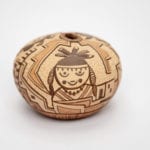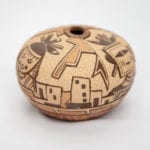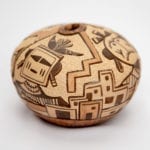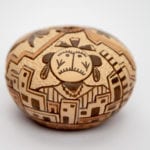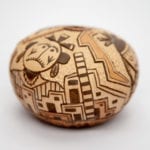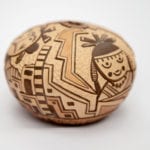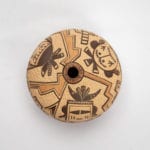- Hahay’iwuuti
- Unknown
- Qööqölö
Around 1900 the innovation known as Sikyati Revival style Hopi pottery ended the 100+ year dominance of Hopi Polacca pottery and established a new standard for Hopi-Tewa and Tewa ceramics. This type, associated with the name Nampeyo, is the dominant style at Hopi and forms the bulk of this collection. In the mid-1930’s Rose Gonzales of Santa Clara Pueblo began making thick-walled pots that she deeply carved with designs. Potters in several pueblos along the Rio Grandss followed her lead. Forty years later other Santa Clara potters began to innovate using scrifito techniques to etch their pottery, sometimes adding pieces of turquoise after firing. Hopi-Tewa Thomas Polacca, son of Fannie Nampeyo, as a young man carved cootonwood root into katchinas, but by the early 1970’s apparently became restless. Drawing on Santa Clara precedent and his own experience, in the late 1970’s Thomas developed a method of producing thick-wall pots that were carved to show scenes of Hopi ritual life. Stodgy collector that I am, the older innovation of ca 1900 attracts me and I am not particularly drawn to to Thomas’ carved innovation, though two of his earlier uncarved pots are part of this collection (2005-09 and 2009-18). Pot 2017-13 was made by Eugene Hamilton, the husband of Tonita Hamilton Nampeyo (1983-01) who is the grandaughter of Nampeyo through Fannie
Seedpot 2017-13 is the first fully-carved Hopi pot in my collection. The mouth of the pot is too small for me to directly measure the thickness of the walls, but the vessel is only moderately heavy, indicating that the walls are fairly thin. When tapped with a finger, it is clear the the pot was kilnfired.
A line encircles the pot about 0.75″ above the base. Below this line the pot retains its original surface. Eugene has covered this area with verigated lines of reddish-brown paint originating from the center of the bottom. A small raised ring with similar paint encircles the mouth. Between the base and the mouth the clay is shallowly carved with a pebble-textured background. A tableau of forms rises above this textured background, these uncarved areas being the original surface of the jar. Details were painted on the raised surfaces, with occasional etching providing some variation.
Emerging from the ring around the mouth are three wide and raised zig-zag forms, like three different forms of lightning. These forms reach to about the waist of the jar and divide the surface into three tableau, each dominated by a different kachina. Lightning, of course, is associated with rain and the need for rain is a core issue for every kachina that visits the Hopi villages and every person on the reservation.
[A note about Hopi spelling:Hopi language varies between the 12 villages and three mesas and is an oral tradition. Words with the same meaning might be formed of very different letters. Thus the published spelling of kachina names for the same kachina varies widely, depending on both the speaker and the translator. Harold Colton (1959) produced the definative guide to kachina “dolls,” and assigned a number to each. In 1998, the first Hopi dictionary was published, Hopi spelling was regularized, and Colton’s spelling was supplanted. Thus one kachina has both an earlier Colton name by which it is known among collectors and a more definative Hopi name in the dictionary. Thanks to Joseph Day, a knowledgable friend on the reservation, (Amerian Indian Art Magazine, 2006: 32(1): 58-65 and 92-93)), I am able to use the official Hopi name but also indicate the Colton designation.]
Above the uncarved verigated base, an interrupted panorama of Hopi homes encircles the pot. Thus each of the three segments of carved surface between the zig-zag lines contains an upper-body depiction of a kachina positioned above a village scene. One segment shows Hahay’iwuuti, Mother of all Kachinas (Colton, 1959:31,#44 as Hahai-i Wu-uti) whose image is also familiar on the flat dolls given to babies. One of her functions is to scold with-a-smile parents for not attending to every need of an infant, the Hahay’iwuuti flat doll serving as a guardian spirit.
A second segment of the carved surface contains a representation of Qööqölö (Colton, 1959:21,#5 as Qoqlo). He announces the winter Bean Dance four days before the event, keeps the dance orderly, predicts good crops for the coming year, and distributes toys to children. Thus he has both serious and playful functions.


